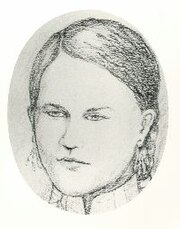Madeline La Framboise
| Madeline La Framboise | |
|---|---|

Artist's depiction from descriptions
|
|
| Born | February 1780 Fort St. Joseph, Michigan |
| Died | April 4, 1846 Mackinac Island |
| Occupation | Fur trader |
| Spouse(s) | Joseph La Framboise |
| Children | Josette and Joseph La Framboise |
Madeline La Framboise (1780–1846), born Marguerite-Magdelaine Marcot, was one of the most successful fur traders in the Northwest Territory of the United States, in the area of present-day western Michigan. Of mixed Odawa and French descent, she was fluent in the Odawa, French, English and Ojibwe languages, and partnered with her husband. After he was murdered, she managed the fur trade successfully for more than a decade. She retired from the trade, building a fine home on Mackinac Island.
As one of the most prominent early businesswomen of Michigan, she was elected in 1984 to the state's Women's Hall of Fame. La Framboise became active in founding a school on Mackinac Island for Native American children, and supporting a Sunday School and other activities at Sainte Anne Church. She donated land for a new site for the church, and was buried beneath its altar.
She was born Marguerite-Magdelaine Marcot in February 1781 at Fort St. Joseph, near present-day Niles, Michigan. She was the youngest of seven children of Jean Baptiste Marcot (1720–1783), a French fur trader. Her mother was Marie Nekesh (c.1740 - c.1790), an Odawa woman also known as Marianne or Marie Amighissen. Her maternal grandfather was Chief Kewinoquot. The children's father was killed in 1783. Therese and Magdelaine, the two youngest children, were baptized as Roman Catholic a few years later on August 1, 1786, on Mackinac Island. When their father was alive, he sent the children to Montreal to be educated, but their mother did not have the financial resources to do that. She moved to Mackinac with Madeline and her sisters after the British abandoned Fort St. Joseph, ceding the area to the United States.
Her mother raised the younger daughters in a Lac Courtes Oreilles village at the mouth of the Grand River. (This has been a federally recognized tribe since 1854.) This area was later developed by European Americans as Grand Haven, Michigan. Therese and Madeline both became fluent in four languages: Ottawa, French, English and Chippewa (Ojibwe).
...
Wikipedia
